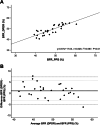Dynamic perfusion digital radiography for predicting pulmonary function after lung cancer resection
- PMID: 33563295
- PMCID: PMC7874664
- DOI: 10.1186/s12957-021-02158-w
Dynamic perfusion digital radiography for predicting pulmonary function after lung cancer resection
Abstract
Background: Accurate prediction of postoperative pulmonary function is important for ensuring the safety of patients undergoing radical resection for lung cancer. Dynamic perfusion digital radiography is an excellent and easy imaging method for detecting blood flow in the lung compared with the less-convenient conventional lung perfusion scintigraphy. As such, the present study aimed to confirm whether dynamic perfusion digital radiography can be evaluated in comparison with pulmonary perfusion scintigraphy in predicting early postoperative pulmonary function and complications.
Methods: Dynamic perfusion digital radiography and spirometry were performed before and 1 and 3 months after radical resection for lung cancer. Correlation coefficients between blood flow ratios calculated using dynamic perfusion digital radiography and pulmonary perfusion scintigraphy were then confirmed in the same cases. In all patients who underwent dynamic perfusion digital radiography, the correlation predicted values calculated from the blood flow ratio, and measured values were examined. Furthermore, ppo%FEV1 or ppo%DLco values, which indicated the risk for perioperative complications, were examined.
Results: A total of 52 participants who satisfied the inclusion criteria were analyzed. Blood flow ratios measured using pulmonary perfusion scintigraphy and dynamic perfusion digital radiography showed excellent correlation and acceptable predictive accuracy. Correlation coefficients between predicted FEV1 values obtained from dynamic perfusion digital radiography or pulmonary perfusion scintigraphy and actual measured values were similar. All patients who underwent dynamic perfusion digital radiography showed excellent correlation between predicted values and those measured using spirometry. A significant difference in ppo%DLco was observed for respiratory complications but not cardiovascular complications.
Conclusions: Our study demonstrated that dynamic perfusion digital radiography can be a suitable alternative to pulmonary perfusion scintigraphy given its ability for predicting postoperative values and the risk for postoperative respiratory complications. Furthermore, it seemed to be an excellent modality because of its advantages, such as simplicity, low cost, and ease in obtaining in-depth respiratory functional information.
Trial registration: Registered at UMIN on October 25, 2017. https://upload.umin.ac.jp/cgi-open-bin/ctr/ctr_his_list.cgi?recptno=R000033957 Registration number: UMIN000029716.
Keywords: Dynamic chest radiography; Dynamic perfusion digital radiography; Prediction of postoperative respiratory function; Pulmonary perfusion; Pulmonary perfusion scintigraphy.
Conflict of interest statement
JH received a research grant from Konica Minolta, Inc. The remaining authors (MY, KH, TS, KO, RK, YK, YO, and AK) have no potential conflicts of interest related with this article.
Figures





Similar articles
-
Reliability of dynamic perfusion digital radiography as an alternative to pulmonary perfusion scintigraphy in predicting postoperative lung function and complications.J Thorac Dis. 2022 Sep;14(9):3234-3244. doi: 10.21037/jtd-22-383. J Thorac Dis. 2022. PMID: 36245586 Free PMC article.
-
[Lung scintigraphy and ergospirometry in prediction of postoperative course in lung resection candidates with increased risk of postoperative complications].Pneumologie. 1996 May;50(5):334-41. Pneumologie. 1996. PMID: 8710817 German.
-
Prediction of postoperative lung function in patients with lung cancer: comparison of quantitative CT with perfusion scintigraphy.AJR Am J Roentgenol. 2002 Mar;178(3):667-72. doi: 10.2214/ajr.178.3.1780667. AJR Am J Roentgenol. 2002. PMID: 11856695
-
[Risk assessment of patients before lung surgery].Chirurg. 1999 Jun;70(6):664-73. doi: 10.1007/s001040050703. Chirurg. 1999. PMID: 10427453 Review. German.
-
Functional evaluation before lung resection.Clin Chest Med. 2002 Mar;23(1):159-72. doi: 10.1016/s0272-5231(03)00066-2. Clin Chest Med. 2002. PMID: 11901909 Review.
Cited by
-
CMaf-Inducing Protein Promotes LUAD Proliferation and Metastasis by Activating the MAPK/ERK Pathway.Evid Based Complement Alternat Med. 2022 Sep 14;2022:2501846. doi: 10.1155/2022/2501846. eCollection 2022. Evid Based Complement Alternat Med. 2022. PMID: 36159575 Free PMC article.
-
Efficient lung cancer detection using computational intelligence and ensemble learning.PLoS One. 2024 Sep 27;19(9):e0310882. doi: 10.1371/journal.pone.0310882. eCollection 2024. PLoS One. 2024. Retraction in: PLoS One. 2025 May 12;20(5):e0324356. doi: 10.1371/journal.pone.0324356. PMID: 39331632 Free PMC article. Retracted.
-
Reliability of dynamic perfusion digital radiography as an alternative to pulmonary perfusion scintigraphy in predicting postoperative lung function and complications.J Thorac Dis. 2022 Sep;14(9):3234-3244. doi: 10.21037/jtd-22-383. J Thorac Dis. 2022. PMID: 36245586 Free PMC article.
-
Relationship between pulmonary blood flow and volume following lung resection using dynamic perfusion digital radiography.J Thorac Dis. 2023 Oct 31;15(10):5593-5604. doi: 10.21037/jtd-23-986. Epub 2023 Oct 8. J Thorac Dis. 2023. PMID: 37969269 Free PMC article.
-
Visual analysis of pulmonary blood flow in pulmonary circulation assessment: differences between two variant algorithms for processing dynamic images.Quant Imaging Med Surg. 2024 Aug 1;14(8):5277-5287. doi: 10.21037/qims-24-152. Epub 2024 Jul 12. Quant Imaging Med Surg. 2024. PMID: 39144062 Free PMC article.
References
-
- Sawabata N, Nagayasu T, Kadota Y, Goto T, Horio H, Mori T, et al. Risk assessment of lung resection for lung cancer according to pulmonary function: republication of systematic review and proposals by guideline committee of the Japanese Association for Chest Surgery 2014. Gen Thorac Cardiovasc Surg. 2015;63:14–21. doi: 10.1007/s11748-014-0475-x. - DOI - PubMed
MeSH terms
LinkOut - more resources
Full Text Sources
Other Literature Sources
Medical
Research Materials

